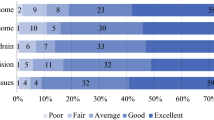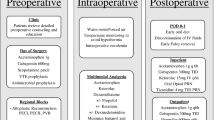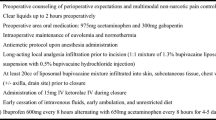Abstract
Background
This study examined the effects of an enhanced recovery program on inpatient opioid requirements and hospital length of stay (LOS) for mastectomy patients undergoing immediate reconstruction.
Methods
An enhanced recovery program for patients undergoing mastectomy with immediate tissue expander (TE) or implant reconstruction was evaluated by comparing a contemporary cohort of 611 patients in 2016–2018 with a historical cohort of 188 patients in 2010. Opioid use and LOS were compared over time and stratified by laterality, mastectomy type, axillary procedure, and reconstruction. Associations were assessed by uni- and multivariate analyses.
Results
In 2010, 95.2% of patients required intravenous (IV) opioids, with a last dose 15.5 h after completion of surgery, compared with 68.7% of patients in 2016–2018, with a last dose 1.8 h after surgery (p < 0.001). Patients prescribed gabapentin postoperatively were less likely to require inpatient IV or oral opioids (p < 0.001). The mean LOS decreased from 37 h in 2010 to 27.5 h in 2016–2018 without an increase in the readmission rate (6.9% vs. 4.1%; p = 0.112). Patients were more likely to stay more than one night if they were older (p = 0.012), had undergone bilateral mastectomies (p < 0.001) or TE reconstruction (p = 0.012), and had surgery in 2010 compared with 2016–2018 (p < 0.001). Even after adjustment for LOS, IV opioid use remained significantly associated with year of surgery (p < 0.001).
Conclusions
Compared with 2010, patients undergoing mastectomy with TE or implant reconstruction in 2016–2018 required less inpatient opioids and had decreased LOS. The authors attribute this to an enhanced recovery program focused on preoperative counseling, non-opioid analgesics, and improved surgical efficiencies.

Similar content being viewed by others
References
Kummerow KL, Du L, Penson DF, Shyr Y, Hooks MA. Nationwide trends in mastectomy for early-stage breast cancer. JAMA Surg. 2015;150:9–16.
Poleshuck EL, Katz J, Andrus CH, et al. Risk factors for chronic pain following breast cancer surgery: a prospective study. J Pain. 2006;7:626–34.
Gassman AA, Yoon AP, Maxhimer JB, et al. Comparison of postoperative pain control in autologous abdominal free flap versus implant-based breast reconstructions. Plast Reconstr Surg. 2015;135:356–67.
Marcusa DP, Mann RA, Cron DC, et al. Prescription opioid use among opioid-naive women undergoing immediate breast reconstruction. Plast Reconstr Surg. 2017;140:1081–90.
Parikh RP, Sharma K, Guffey R, Myckatyn TM. Preoperative paravertebral block improves postoperative pain control and reduces hospital length of stay in patients undergoing autologous breast reconstruction after mastectomy for breast cancer. Ann Surg Oncol. 2016;23:4262–9.
Terkawi AS, Tsang S, Sessler DI, et al. Improving analgesic efficacy and safety of thoracic paravertebral block for breast surgery: a mixed-effects meta-analysis. Pain Physician. 2015;18:E757–80.
Tahiri Y, Tran DQ, Bouteaud J, et al. General anaesthesia versus thoracic paravertebral block for breast surgery: a meta-analysis. J Plast Reconstr Aesthet Surg. 2011;64:1261–9.
de Kok M, Dirksen CD, Kessels AG, et al. Cost-effectiveness of a short stay admission programme for breast cancer surgery. Acta Oncol. 2010;49:338–46.
Stone AB, Grant MC, Pio Roda C, et al. Implementation costs of an enhanced recovery after surgery program in the United States: a financial model and sensitivity analysis based on experiences at a quaternary academic medical center. J Am Coll Surg. 2016;222:219–25.
Boughey JC, Goravanchi F, Parris RN, et al. Improved postoperative pain control using thoracic paravertebral block for breast operations. Breast J. 2009;15:483–8.
Boughey JC, Goravanchi F, Parris RN, et al. Prospective randomized trial of paravertebral block for patients undergoing breast cancer surgery. Am J Surg. 2009;198:720–5.
Kairaluoma PM, Bachmann MS, Korpinen AK, Rosenberg PH, Pere PJ. Single-injection paravertebral block before general anesthesia enhances analgesia after breast cancer surgery with and without associated lymph node biopsy. Anesth Analg. 2004;99:1837–43, Table of Contents.
Schnabel A, Reichl SU, Kranke P, Pogatzki-Zahn EM, Zahn PK. Efficacy and safety of paravertebral blocks in breast surgery: a meta-analysis of randomized controlled trials. Br J Anaesth. 2010;105:842–52.
Aufforth R, Jain J, Morreale J, Baumgarten R, Falk J, Wesen C. Paravertebral blocks in breast cancer surgery: is there a difference in postoperative pain, nausea, and vomiting? Ann Surg Oncol. 2012;19:548–52.
Bhuvaneswari V, Wig J, Mathew PJ, Singh G. Postoperative pain and analgesic requirements after paravertebral block for mastectomy: a randomized controlled trial of different concentrations of bupivacaine and fentanyl. Indian J Anaesth. 2012;56:34–9.
Fahy AS, Jakub JW, Dy BM, et al. Paravertebral blocks in patients undergoing mastectomy with or without immediate reconstruction provides improved pain control and decreased postoperative nausea and vomiting. Ann Surg Oncol. 2014;21:3284–9.
Wolf O, Clemens MW, Purugganan RV, et al. A prospective, randomized, controlled trial of paravertebral block versus general anesthesia alone for prosthetic breast reconstruction. Plast Reconstr Surg. 2016;137:660e–6e.
Offodile AC II, Aycart MA, Segal JB. Comparative effectiveness of preoperative paravertebral block for post-mastectomy reconstruction: a systematic review of the literature. Ann Surg Oncol. 2018;25:818–28.
Coopey SB, Specht MC, Warren L, Smith BL, Winograd JM, Fleischmann K. Use of preoperative paravertebral block decreases length of stay in patients undergoing mastectomy plus immediate reconstruction. Ann Surg Oncol. 2013;20:1282–6.
Temple-Oberle C, Shea-Budgell MA, Tan M, et al. Consensus review of optimal perioperative care in breast reconstruction: enhanced recovery after surgery (ERAS) society recommendations. Plast Reconstr Surg. 2017;139:1056e–71e.
Offodile AC II, Gu C, Boukovalas S, et al. Enhanced recovery after surgery (ERAS) pathways in breast reconstruction: systematic review and meta-analysis of the literature. Breast Cancer Res Treat. 2019;173:65–77.
Batdorf NJ, Lemaine V, Lovely JK, et al. Enhanced recovery after surgery in microvascular breast reconstruction. J Plast Reconstr Aesthet Surg. 2015;68:395–402.
Weltz CR, Greengrass RA, Lyerly HK. Ambulatory surgical management of breast carcinoma using paravertebral block. Ann Surg. 1995;222:19–26.
Dumestre DO, Webb CE, Temple-Oberle C. Improved recovery experience achieved for women undergoing implant-based breast reconstruction using an enhanced recovery after surgery model. Plast Reconstr Surg. 2017;139:550–9.
Acknowledgement
This study was conducted with support from Harvard Catalyst/The Harvard Clinical and Translational Science Center (National Center for Advancing Translational Sciences, National Institutes of Health Award UL 1TR002541) and financial contributions from Harvard University and its affiliated academic health care centers. The content is solely the responsibility of the authors and does not necessarily represent the official views of Harvard Catalyst, Harvard University and its affiliated academic healthcare centers, or the National Institutes of Health.
Author information
Authors and Affiliations
Corresponding author
Ethics declarations
Disclosure
All authors declare that they have no conflict of interest.
Additional information
Publisher's Note
Springer Nature remains neutral with regard to jurisdictional claims in published maps and institutional affiliations.
Selected for poster presentation at the 2019 Society of Surgical Oncology Annual Meeting, San Diego, CA, March 2019.
Rights and permissions
About this article
Cite this article
McGugin, C.J., Coopey, S.B., Smith, B.L. et al. Enhanced Recovery Minimizes Opioid Use and Hospital Stay for Patients Undergoing Mastectomy with Reconstruction. Ann Surg Oncol 26, 3464–3471 (2019). https://doi.org/10.1245/s10434-019-07710-3
Received:
Published:
Issue Date:
DOI: https://doi.org/10.1245/s10434-019-07710-3




